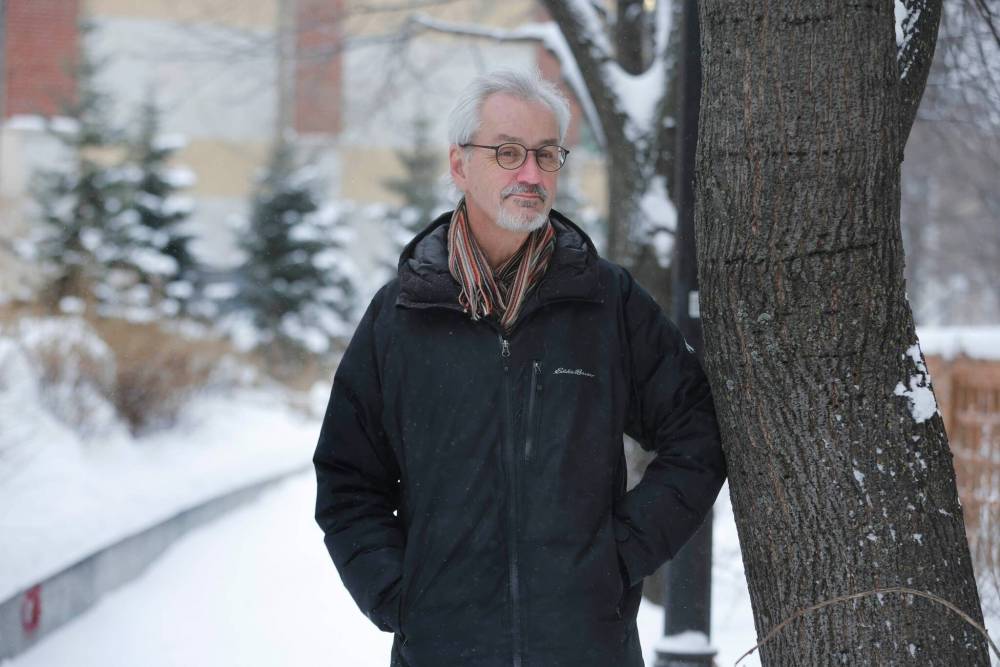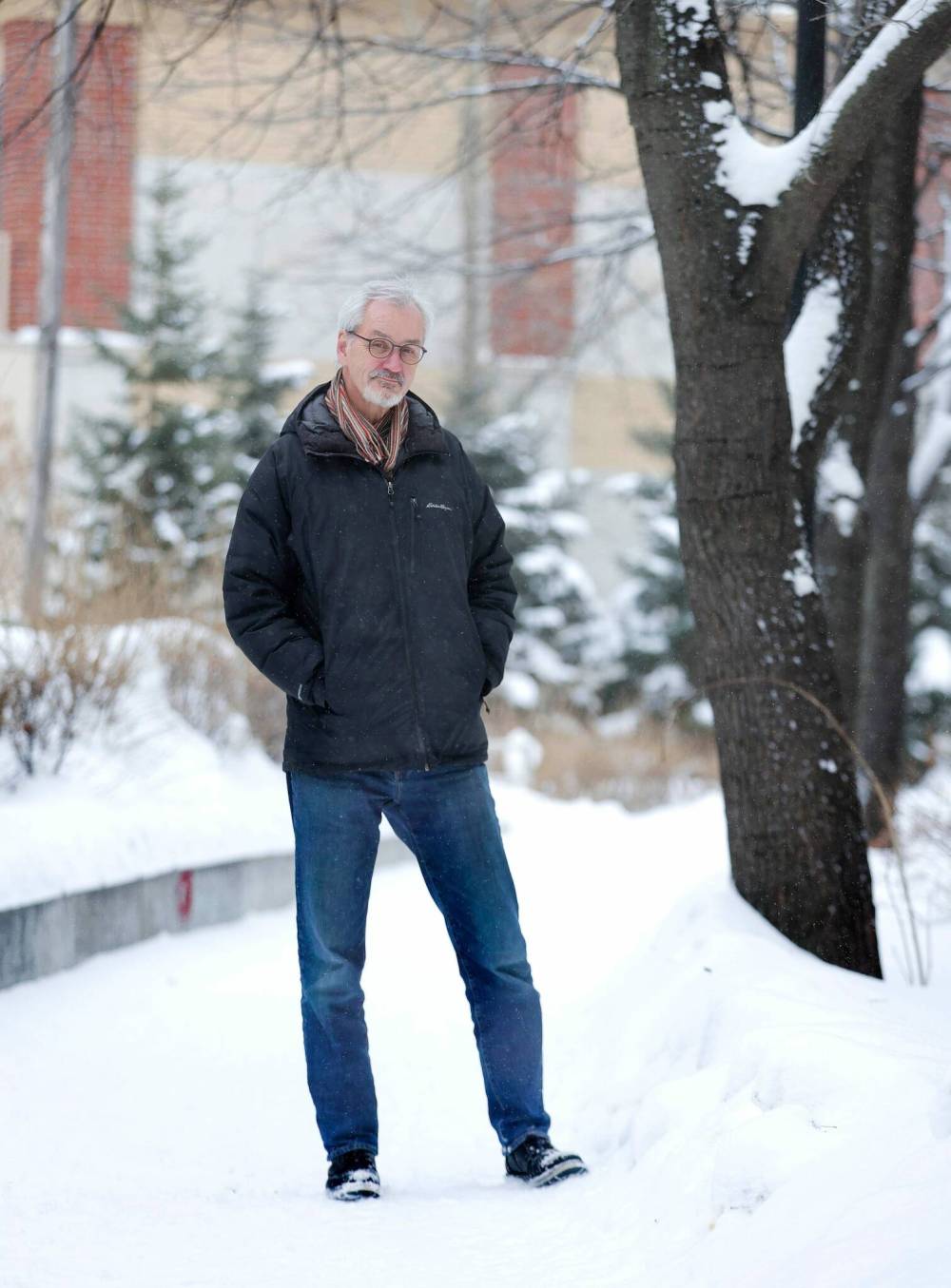
Winnipeg’s downtown is a concrete jungle.
In the maze of office towers and asphalt, surface parking lots are more common than parks. The city’s harsh weather and abundance of pavement have choked out trees; on summer days heat sticks to the pavement and lingers in the air. The city’s own data shows the downtown is home to fewer trees, fewer parks and hotter average summer temperatures than other parts of the city.
With a warming climate that promises to bring more frequent and powerful storms, heat waves, and extreme weather events, the urban desert leaves downtown Winnipeg residents — many of whom live in higher levels of poverty than their suburban neighbours — increasingly vulnerable to illness and death.
It’s a slow-growing crisis — but Winnipeg isn’t alone.
In the sprawling prairie city of Edmonton, Alta., which is facing a slate of downtown crises similar to Winnipeg’s, the downtown “can look like a barren wasteland,” says Alex Hryciw, who chairs Edmonton’s Downtown Recovery Coalition.
SUPPLIED “National infrastructure is so critical to sustaining recovery throughout our central business district,” says Alex Hryciw, who chairs Edmonton’s Downtown Recovery Coalition.
A wasteland is bad for business and not likely to help protect the city from the impacts of a warming climate. So Edmonton has decided to turn parking lots into paradise, repurposing seven paved lots into more than two football fields’ worth of lush, green downtown park.
“I think cities are starting to understand that there’s not going to be another major build, there’s not going to be a hotel or an arena or something else that’s going to save our downtown,” Hryciw says.
“If we want our downtowns to be sustainable, we have to bring that sense of calmness back into the core.”
The unofficially named Warehouse Park is part of a broad new vision in Edmonton that aims to make natural spaces — and natural infrastructure — the new norm. It’s a vision echoed across the country as the idea of living cities, where greenspace is widespread and sustainable, begins to take hold. If applied in Winnipeg, widespread natural infrastructure could breathe new life, health and climate resilience into the city’s downtown core.
SUPPLIED City of Edmonton’s Warehouse Park is set to be completed in 2025.
Over the last two decades, Canada on the whole has gotten less green. According to Statistics Canada, the average amount of urban land covered by healthy vegetation dropped eight percentage points nationwide between 2000 and 2022. Winnipeg saw the second highest loss of green in that time period — after Milton, Ont. — losing 37 per cent of its lush urban lands.
Such a significant loss of greenery isn’t just an eyesore; it’s bad for health. Combining more intense weather with a tendency toward concrete gridlock makes a downtown more susceptible to climate-related crises such as floods and heat islands. In downtown Winnipeg, home to many of the city’s newcomers, Indigenous peoples and people living in poverty, it is the most vulnerable residents who bear the most grievous impacts of a changing climate.
By contrast, more nature and greenery is thought to encourage walking, cycling, community cohesion and environmental education. Studies have shown greenspace reduces the risks of diabetes, cardiovascular disease, stroke, dementia and respiratory illness. Greenery is shown to reduce anxiety and depression, while lowering mortality risks.
That’s why policy experts have started emphasizing the need for natural, or green, infrastructure — things like wetlands, woodlands, parks, street trees, green roofs, community gardens and, to target water pooling on roadways, permeable pavements.
“It’s all the sorts of things that help our cities to function like a natural system, and use the power of nature to address some of the challenges related to climate change,” says Brianna Salmon, executive director of climate-action nonprofit Green Communities Canada.
SUPPLIED The three pillars that define a living city are “equitable, abundant and thriving” green infrastructure, says Brianna Salmon, executive director of climate-action nonprofit Green Communities Canada.
“We know that nature based solutions are effective at managing floods, helping rainwater to drain where it falls, that city centres are cooler when there’s green infrastructure, that they reduce urban heat-island effect.”
Beyond the environmental benefits, green infrastructure is a boon to social, mental and physical wellbeing, can help provide food security for residents who need it and, in the long term, is less costly than traditional infrastructure, Salmon explains.
The three pillars that define a living city are “equitable, abundant and thriving” green infrastructure, Salmon says.
That means parks, trees, community gardens and other greenery are adequately funded, well-maintained and prioritized in places with the greatest need — places where people are most vulnerable to the effects of climate change. Those communities, Salmon says, should not only benefit from green infrastructure, but also help plan, design and “bring it to life with their hands and their hearts.”
Above all, living cities are places where green infrastructure is “the new normal,” she adds.
Rather than a series of small demonstration projects, living cities integrate green infrastructure into policy decisions, design considerations and long-term municipal planning.
“It’s really thinking about it as being a primary solution to creating more sustainable, climate-resilient and nature-rich cities,” Salmon says. “Green infrastructure can meet communities where they’re at; it’s such a hopeful and positive way to be thinking about developing our cities.”
“It’s really thinking about it as being a primary solution to creating more sustainable, climate-resilient and nature-rich cities.”–Brianna Salmon
The idea of green infrastructure isn’t new to Winnipeg. The city’s climate action plan, active-transportation and urban-forest strategies all recognize the importance of green infrastructure, citing benefits to the environment, mental and physical wellbeing, and the city budgets. Winnipeg attractions like the winter river trails, The Forks and the Assiniboine Forest all incorporate elements of green infrastructure by encouraging residents to preserve and engage with the natural world.
And in the downtown, where 150 surface parking lots cover 20 per cent of the core according to 2018 figures, a group of landscape architects are working to introduce more natural infrastructure by adding parks, trees and other simple environmental solutions to the maze of concrete.
“The first thing we think about when we’re doing any kind of urban design is how is this going to function from a social standpoint. It has to be usable, it has to be liveable and attractive and make people comfortable,” says Glen Manning, principal architect at HTFC Planning and Design.
“Providing overhead canopy and the pleasure of being in a space with lots of plants, those contribute to liveability.”
RUTH BONNEVILLE / WINNIPEG FREE PRESS Glen Manning, principal architect at HTFC Planning and Design, has been involved in a series of downtown green-infrastructure projects.
Manning has been involved in a series of downtown green-infrastructure projects. He helped design a tangle of trees and shrubbery at Manitoba Hydro Place; he helped revitalize the courtyard at downtown’s Steinkopf Gardens; he contributed to the oasis of prairie grasslands, mini-wetlands and rainwater harvest systems at Millenium Library Park. He’s even been working with the city to come up with a better way to plant trees downtown. To Manning, green infrastructure isn’t just possible in Winnipeg — “it’s inevitable.”
“Green infrastructure is where we can do things like stormwater management, improving our water quality, energy consumption reduction, air quality — all sorts of benefits arise out of doing things that have this ability to serve the resiliency requirements,” Manning says.
But downtown Winnipeg presents a unique challenge for green urban design. The soil beneath the city is a dense clay, the weather can be harsh, pavement abounds, and road salt and construction threaten the health of inner-city greenery.
“That means that a lot of the things that other places are doing as part of their spectrum of green-infrastructure solutions don’t really work the same way here,” Manning says.
Winnipeg is working with a narrow selection of plants and trees able to withstand the difficult conditions, but the city has started to find ways to extend the life of its downtown greenery.
“Green infrastructure is where we can do things like stormwater management, improving our water quality, energy consumption reduction, air quality — all sorts of benefits arise out of doing things that have this ability to serve the resiliency requirements.”–Glen Manning
Street trees, for example, used to be planted in three-foot by three-foot pots nestled into holes in the sidewalk. Those trees lacked soil and nutrients, and often died within a decade. Now, Manning says, he’s helping the city incorporate soil cells — crates of soil that can be installed underneath sidewalk pavement — to help give the trees enough soil volume to grow. That soil also helps retain stormwater, reducing stress on the city’s aging sewage system.
RUTH BONNEVILLE / WINNIPEG FREE PRESS “Providing overhead canopy and the pleasure of being in a space with lots of plants, those contribute to liveability,” Glen Manning, principal architect at HTFC Planning and Design.
While HTFC’s design projects have so far been a success — Manning points to the vibrant hum of activity at the Manitoba Hydro Place park on summer days, for example — green infrastructure projects have been moving slowly in the city centre.
“A lot of these technologies are pretty much accepted, they’re almost standard and they’re required by bylaws in some cities,” Manning says. “In Winnipeg we’re not there yet, so we don’t have that same kind of urgency to address these things.”
In a city like Winnipeg, green infrastructure can feel risky for developers. The upfront costs can be steep and the city hasn’t yet studied, modelled and proven the benefits of green solutions.
“No one wants to be a pioneer,” Manning says. “It would be reassuring to developers and administrators of various stripes to know these things are tested and understood and functioning well.”
As in Winnipeg, Edmonton’s downtown is challenged by harsh weather, aging infrastructure and limited political attention.
“Our city, as an administration, has to prioritize every area of the city equitably, which means the downtown doesn’t always fall into a regular rhythm of neighbourhood renewal,” Hyrciw explains.
“We really are trying to ready our bureaucracy within the city to understand that in order to achieve what we want to see, all of these incremental policies like natural infrastructure, tree canopies and plant life matter.”
But Warehouse Park, set to be completed in 2025, could be a catalyst for changing priorities.
SUPPLIED The unofficially named Warehouse Park is part of a broad new vision in Edmonton that aims to make natural spaces — and natural infrastructure — the new norm.
“The concept is public investment in public infrastructure in order to realize private investment,” says senior city planner Claire St. Aubin.
Edmonton had been planning for a downtown park since 2010 in the hopes a new greenspace would lead to more foot traffic and economic development. They spent $36 million buying and expropriating land (including seven paved parking lots), and budgeted another $42 million on designing and building the park.
Those major investments have brought major returns. Private developers are already planning to build more than 3,000 residential units within walking distance of the park, and those buildings will include mixed-use space for new businesses.
“Where there is high-value land, where there is marketable land, is where people have access to and can see greenspace,” St. Aubin says.
SUPPLIED Warehouse park is just one of a network of green infrastructure projects Edmonton is working to integrate in the coming years as part of an overarching “green and walkable” downtown strategy, says senior city planner Claire St. Aubin.
“What we’re seeing in common Western culture these days is all this discussion about how healthy it is, how good it is for our psychological and physical wellbeing to be in and around green.”
Warehouse park is just one of a network of green infrastructure projects Edmonton is working to integrate in the coming years as part of an overarching “green and walkable” downtown strategy, St. Aubin says. In the eastern downtown neighbourhood of The Quarters, the city started piloting “green streets” lined with soil for healthy urban forest growth, and plans to develop green pathways that link the neighbourhood to the nearby river valley.
The city has found success getting private investors to buy into the green vision by emphasizing the role vibrancy plays in safe, comfortable, economically thriving downtowns. They’ve secured federal money from green infrastructure funds, and encouraged private developers to see a greener downtown as a stronger tourist attraction.
“National infrastructure is so critical to sustaining recovery throughout our central business district,” Hryciw says.
In her role as sustainable transportation co-ordinator at the Green Action Centre, Mel Marginet has transformative dreams for Winnipeg’s downtown that would see a focus on sustainable, walkable neighbourhoods replace the existing web of car-centric and pedestrian-hostile infrastructure.
“If I could wave my magic wand, the downtown would be a super exciting place to walk with lots of shade trees and no empty surface parking lots,” Marginet says.
“Natural infrastructure is really critical because we can tackle so many problems at once, from a climate perspective, to habitats for birds and bees … we will always be happier and healthier when we work in sync with nature.”
Simple changes like wider sidewalks, more shade trees, protected bike lanes and a return to two-way motorist traffic could all help improve the vibrancy in downtown Winnipeg, she says. Parks and greenspace are “vitally important,” too.
“Natural infrastructure is really critical because we can tackle so many problems at once, from a climate perspective, to habitats for birds and bees … we will always be happier and healthier when we work in sync with nature.”–Mel Marginet
“Not only for making our cities more comfortable … but also for that public space,” Marginet says.
“Spontaneous interactions with your neighbours create that sense of safety, looking out for each other.”
These dreams aren’t “pie in the sky,” she says. Winnipeg’s existing policy documents and planning frameworks — including an award-winning walking and cycling strategy that would see more pathways and greenspace throughout the city — already emphasize the importance of green infrastructure in the city’s future. The only hurdle left to cross is securing political will.
“It hasn’t taken very long for us to get to this very terrible place,” Marginet says. “By putting our heads together and following best practices elsewhere, we can get out of it quite quickly.”

Julia-Simone Rutgers
Reporter
Julia-Simone Rutgers is a climate reporter with a focus on environmental issues in Manitoba. Her position is part of a three-year partnership between the Winnipeg Free Press and The Narwhal, funded by the Winnipeg Foundation.
Read full biography


